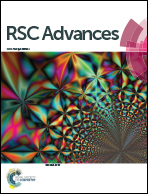Self-cleaning expanded polytetrafluoroethylene-based hybrid membrane for water filtration†
Abstract
Membrane surface fouling is a key problem for water filtration. Compositing photocatalytic substances with a base membrane is a widely used strategy, but most of the membrane will be decomposed by photocatalysis. Herein, expanded polytetrafluoroethylene (ePTFE) with extremely stable chemical properties is grafted with polyacrylic acid (PAA) and then modified with titanium dioxide (TiO2) to realize a self-cleaning TiO2–PAA–ePTFE filtration membrane. It can recover its flux under UV irradiation after fouling. With 20 rounds of self-cleaning, the membrane microstructure still remains intact. Moreover, in addition to retaining bovine serum albumin, TiO2 particles on the membrane surface are capable of absorbing small organic pollutants and degrading them. Thus, this membrane is potentially used as an anti-fouling membrane for water filtration.



 Please wait while we load your content...
Please wait while we load your content...